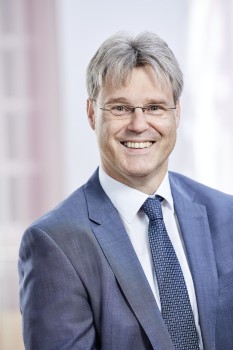
Innovative Research through interdisciplinary collaboration
Vice-Rector for Internationalization and
Knowledge TransferThe University of Münster is very well positioned as regards interdisciplinary research. It is a university offering the full range of subjects, and practically all of these subjects are located on site, making interdisciplinary collaboration easily possible. In addition, the University has strong research activities in both the major academic groupings of subjects – the Humanities and the Natural Sciences. This has – through the establishment of research alliances within these subject groupings – led not only to an interdisciplinarity which has proved its worth, but also to large-scale interdisciplinarity across both groupings. For years now, there has been a growing tendency to pass pressing social challenges to universities in the form of questions and assignments. In many cases, these questions cannot be addressed by individual disciplines. In many contexts – for example, sustainability – what is required is collaboration between the Humanities, Social Sciences and Natural Sciences. At Münster, this finds expression for example in the University’s transfer concept.

Interdisciplinary collaboration in academic work can basically be characterised as “thinking outside the box”. From those involved this requires two things in equal measure: clear subject competence and identity – i.e. a knowledge, on the one hand, of what one’s own subject is responsible for and capable of, regarding both methodology and content, as well as an awareness of its limits – and, on the other hand, a willingness to engage in the perspectives and identities of the disciplines represented by the other people involved. As a result, researchers not only gain a deeper understanding of their own discipline, but can also develop a common understanding of problems through interdisciplinary exchanges. This frequently leads to innovative questions and approaches to research. It is for this reason that Münster University is banking on interdisciplinarity as a central element in its research and excellence strategy.
Looking beyond the bounds of their own subjects also provides additional benefits for students. It is not only our trainee teachers who already combine two different subjects in their bachelor’s degree courses. Taking part in interdisciplinary research – which can flow into teaching in the form of learning through research, for example – enables students to develop a better, deeper understanding of elements peculiar to their subject, just as it does for researchers too. Ultimately, an interdisciplinary approach to complex questions enables them to train their ability to grasp such complexities and adequately and systematically address them in interdisciplinary collaboration.
The challenges of interdisciplinary working are, however, manifold. Because a clear awareness of one’s own subject-related identity is the pre-requirement for interdisciplinary collaboration and networking, it cannot replace subject training. For this reason, an interdisciplinary orientation in students’ own research should not take place at too early a stage in their studies and should always stay connected to a further development of their own research profile in their subject. Over and above this predominantly methodological aspect, there is a further challenge in a student’s own qualification phase which, as a rule, follows a logic inherent in the subject. Doctoral students working in interdisciplinary research alliances, for example, have to achieve two things: they have to shape their own subject profile and develop an interdisciplinary understanding. This is not easy to achieve – neither for junior researchers, nor for their supervisors. But interdisciplinarity also entails challenges from an institutional point of view. In order for contacts to be made beyond the pathways and contexts of individual subjects, structures are necessary which enable and stimulate this collaboration. A key task which the faculties and the University management have is to create the appropriate framework and encourage its researchers to embark on what are often new paths. To this end, the University of Münster provides support in developing large-scale research alliances such as Collaborative Research Centres or Clusters of Excellence, among other things.
Author Prof. Michael Quante is Vice-Rector for Internationalization and Knowledge Transfer at the University of Münster.
This article first appeared in the University newspaper wissen|leben No. 1, 2 February 2023.
